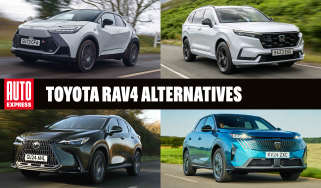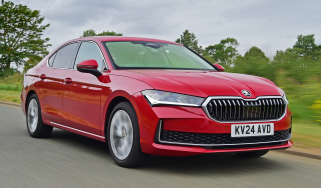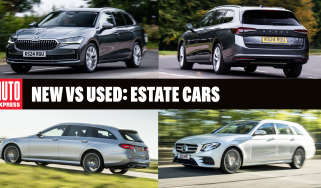Safest cars for sale in the UK 2025
These are the cars that have aced Euro NCAP’s safety testing

No matter which type of car you’re thinking of buying, or what you’re planning to use it for, you’ll understandably want to keep yourself and any passengers as safe as possible. The good news is that as safety technology continues to develop at a rapid pace, the safest cars for sale in the UK now offer more advanced systems and protection than ever before.
Rather than simply taking car brands at their word about how well their models stand up to a crash, though, Euro NCAP puts them through rigorous testing to determine the safest cars you can buy. It’s the outcome of these expert tests that have resulted in our list of the safest cars you can buy in the UK.
How do Euro NCAP safety ratings work?
Euro NCAP is an independent safety testing organisation that conducts various tests on new cars to determine how they structurally withstand a severe impact and how effectively their advanced safety systems operate.
Once the testing is complete, the scores are broken down into four key categories; adult occupant, child occupant, vulnerable road users and safety assist. These scores then contribute towards an overall safety rating which is measured using a star system (similar to our in-depth reviews).
It’s important to note, though, that Euro NCAP regularly updates its testing regime. In 2023, several new measures were introduced, including increased penalties for poor adult occupant protection performance, additional brain injury criteria, expanded post-crash technology testing and a vehicle submergence test. As a result of this increased stringency, tests carried out prior to 2023 are not directly comparable to those which have taken place since, so they have been omitted from this list.
There are a reassuring number of five-star cars on the current market, so our list of the 10 safest cars on sale in the UK is based on the top 10 ranked by Euro NCAP that are on sale in the UK. You can read our in-depth guide to Euro NCAP safety testing here...
Mercedes E-Class
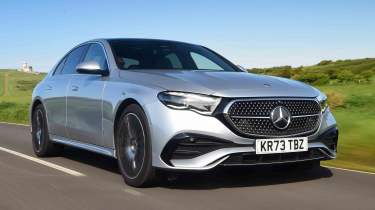
- Prices from £55,000
- Euro NCAP Rating: 5 stars (2024)
- Adult occupant score: 92%
- Child occupant score: 90%
- Vulnerable road users score: 84%
- Safety assist score: 87%
The latest Mercedes E-Class is the most tech-filled generation yet, and this includes a healthy list of active safety kit. Merc’s executive saloon hasn’t lost sight of its roots, though, as it’s still an exceptionally comfortable place to be, and it’ll cover plenty of miles in a very refined manner. Long journeys shouldn’t cost a fortune, either, as even the entry-level petrol variant officially returns over 40mpg.
Skoda Superb
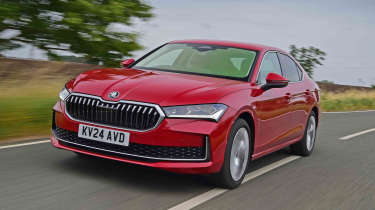
- Prices from £35,000
- Euro NCAP Rating: 5 stars (2024)
- Adult occupant score: 93%
- Child occupant score: 87%
- Vulnerable road users score: 82%
- Safety assist score: 80%
The Skoda Superb offers a number of premium car touches, but at a slightly more humble starting price. Along with its upmarket feel, the Superb is still hugely practical and suitable for family car duties thanks to its spacious cabin and 645-litre boot. If you want maximum space, there’s always the option of the estate version, which just so happens to be our 2024 Estate Car of the Year.
Volkswagen Passat
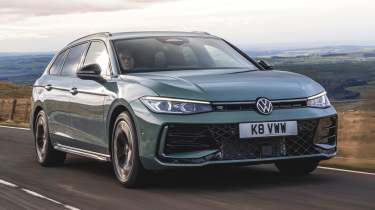
- Prices from £38,500
- Euro NCAP Rating: 5 stars (2024)
- Adult occupant score: 93%
- Child occupant score: 87%
- Vulnerable road users score: 82%
- Safety assist score: 80%
The latest Volkswagen Passat is closely related to the Skoda Superb, and both cars share the exact same safety scores. Unlike its Czech counterpart, though, the VW is only available as an estate car. This isn’t exactly a bad thing, though, as there’s acres of space inside. If you don’t mind losing a little bit of boot capacity, the plug-in hybrid model can return up to 77 miles of pure-electric range.
Audi Q6 e-tron
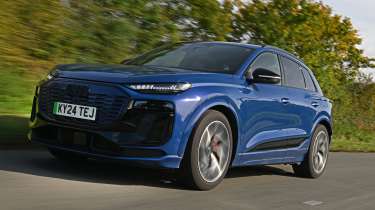
- Prices from £61,000
- Euro NCAP Rating: 5 stars (2024)
- Adult occupant score: 91%
- Child occupant score: 92%
- Vulnerable road users score: 81%
- Safety assist score: 80%
Take a seat inside the Audi Q6 e-tron and its sheer size will provide some reassurance when it comes to safety, and that’s before its five-star rating is even taken into account. Naturally, all of this bulk means a fair helping of space inside, too, while the on-board technology is among the best in the competitive electric SUV class at the moment.
Mazda CX-80
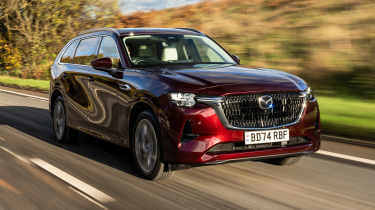
- Prices from £48,900
- Euro NCAP Rating: 5 stars (2024)
- Adult occupant score: 92%
- Child occupant score: 88%
- Vulnerable road users score: 84%
- Safety assist score: 79%
There is a lot to like about the seven-seat Mazda CX-80, including a huge amount of space inside. All occupants are well looked after because the Mazda scored highly for adult and child occupancy safety, and the CX-80 looks after other road users, too. Premium looks and feel don’t come with an excessive price tag, while the plug-in hybrid petrol or diesel engines offer low running costs.
Maxus eTERRON 9
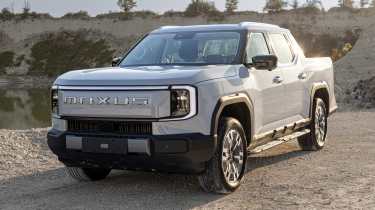
- Prices from £63,600
- Euro NCAP Rating: 5 stars (2024)
- Adult occupant score: 91%
- Child occupant score: 85%
- Vulnerable road users score: 84%
- Safety assist score: 83%
Maxus may be a name more familiar to van buyers, but the company is now turning its attention to the car market with its pick-up eTERRON 9. A strong rival for the likes of the Ford Ranger and KGM Musso, the Maxus has gained a big lead when it comes to safety with its five-star rating from Euro NCAP. The electric pick-up has a range of 267 miles, can tow 3500kg and carry up to 620kg while transporting five adults.
Porsche Macan
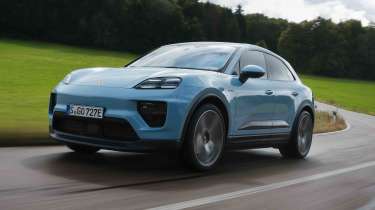
- Prices from £56,000
- Euro NCAP Rating: 5 stars (2024)
- Adult occupant score: 90%
- Child occupant score: 90%
- Vulnerable road users score: 83%
- Safety assist score: 78%
Safety is a key consideration for all car buyers and that includes anyone choosing a performance model, so it’s good to know you can have thrills without the spills with the Porsche Macan. This SUV is only marginally let down by its Safety Assist score, but it remains an impressive all-rounder for looking after its occupants and entertaining its driver, whether you opt for a petrol or electric version.
Maxus Mifa 7
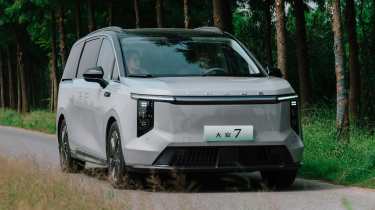
- Prices from £49,000
- Euro NCAP Rating: 5 stars (2024)
- Adult occupant score: 92%
- Child occupant score: 87%
- Vulnerable road users score: 81%
- Safety assist score: 75%
Although it started out as a van maker, Maxus is now starting to creep into other areas of the market, and the Mifa 7 is the brand’s second luxury MPV. This fully electric car can return up to 298 miles on the WLTP combined cycle, and the brand has been pretty generous with the standard kit, too. Along with electronic doors and a panoramic sunroof, the Mifa 7 comes with active safety tech including autonomous emergency braking, adaptive cruise control, lane-keeping assist and forward collision warning.
Cupra Tavascan

- Prices from £47,300
- Euro NCAP Rating: 5 stars (2024)
- Adult occupant score: 89%
- Child occupant score: 86%
- Vulnerable road users score: 80%
- Safety assist score: 79%
The Cupra Tavascan is by far and away the Spanish firm’s best EV so far thanks to ride comfort and refinement. It can also add an excellent safety result to that list with its appearance in the top 10 here. The Tavascan scored very well for child occupancy safety to make it an ideal option for family buyers looking for an electric SUV with a decent range, with the Cupra covering 352 miles on a charge.
Toyota C-HR
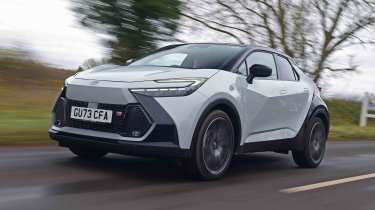
- Prices from £31,300
- Euro NCAP Rating: 5 stars (2024)
- Adult occupant score: 85%
- Child occupant score: 86%
- Vulnerable road users score: 86%
- Safety assist score: 79%
The first thing you notice about the Toyota C-HR is its dramatic looks; the body is full of creases, edges, and points. Look a little deeper, though, and you find a very good hybrid small SUV that’s excellent to drive and comes with an extensive list of safety kit. That helps the C-HR record a superb score with Euro NCAP, although it’s not quite as roomy in the rear seats as some other rivals with a five-star safety rating.
Five-star Euro NCAP cars
Here are all the cars that you can buy in the UK with a full five-star rating from Euro NCAP’s latest testing.
Safest cars tested in 2024
| Adult occupant | Child occupant | Vulnerable road users | Safety assist | |
| Mercedes E-Class | 92% | 90% | 84% | 87% |
| Skoda Superb | 93% | 87% | 82% | 80% |
| Volkswagen Passat | 93% | 87% | 82% | 80% |
| Audi Q6 e-tron | 91% | 92% | 81% | 80% |
| Mazda CX-80 | 92% | 88% | 84% | 79% |
| Mazda eTerron 9 | 91% | 85% | 84% | 83% |
| Porsche Macan | 90% | 90% | 83% | 78% |
| Maxus Mifa 7 | 92% | 87% | 81% | 75% |
| Toyota C-HR | 85% | 86% | 86% | 79% |
| MG HS | 90% | 85% | 83% | 74% |
| Skoda Kodiaq | 89% | 83% | 82% | 78% |
| Ford Explorer | 89% | 86% | 80% | 72% |
| Ford Capri | 89% | 86% | 80% | 72% |
| Cupra Tavascan | 89% | 86% | 80% | 79% |
| Honda CR-V (with safety pack) | 85% | 86% | 80% | 79% |
| Volkswagen Tiguan | 83% | 88% | 84% | 78% |
| Subaru Impreza | 83% | 90% | 84% | 72% |
| Subaru Crosstrek | 83% | 90% | 85% | 72% |
Safest cars tested in 2023
| Adult occupant | Child occupant | Vulnerable road users | Safety assist | |
| Volkswagen ID.7 | 95% | 88% | 83% | 80% |
| Smart #3 | 90% | 86% | 84% | 85% |
| BYD Dolphin | 89% | 87% | 85% | 79% |
| Mercedes EQE SUV | 87% | 90% | 80% | 85% |
| Lexus RZ | 87% | 87% | 84% | 81% |
| BYD Seal | 89% | 87% | 82% | 76% |
| BYD Seal U | 90% | 86% | 83% | 77% |
| BMW 5 Series | 89% | 85% | 86% | 78% |
| Kia EV9 | 84% | 88% | 76% | 83% |

